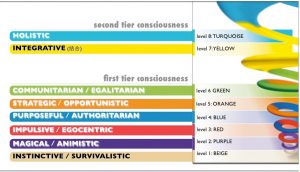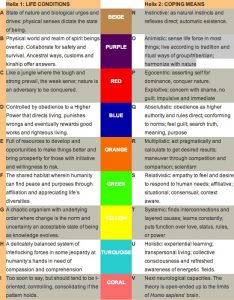Coming to Terms with the Spiral
 As we roll into 2017, I think most of us would agree that last year was a very different and yet illuminating year. With our recent Presidential Campaign circus, and the subsequent surprising election results, many of us -- living in the little worlds that we inevitably live in -- have been struggling to understand what is happening in the wider world.
As we roll into 2017, I think most of us would agree that last year was a very different and yet illuminating year. With our recent Presidential Campaign circus, and the subsequent surprising election results, many of us -- living in the little worlds that we inevitably live in -- have been struggling to understand what is happening in the wider world.
I readily admit, I have been at a loss to answer this question about what is going on right now in the wider world. I mean, what do Brexit, the US Presidential Election Results, Syria, and ISIS, say about all of humanity, not just our little world's realities?
Spiral Dynamics?
These questions about the wide wide world -- sorry folks this is not the World Wide Web; not everything can be solved through computing or social media offerings -- naturally send us analytical types out on a search for some framework or model that explains, well, everything.
This is perhaps where Spiral Dynamics comes in: first written and published by Donald Edward Beck and Christopher Cowan in 1996, this theory on how everything fits together, is written in a slightly New Age style, but almost feels like it could have gone through its first drafts in the late 1970's (when the Spiral Dynamics concepts were first being conceived). Even with this slightly gruesome writing style to navigate through, Spiral Dynamics has a lot to offer those of us puzzled by recent events.
The Basic Concept of Spiral Dynamics is that although human history seems to repeat itself, seeming to circle back to prior human practices, the pendulum of cultural swings traces more of a spiral than a true circle. As William Butler Yeats would say our world is "Turning and turning in the widening gyre."
Specifically, the authors of Spiral Dynamics, Mr. Beck and Mr. Cowan, describe multiple states or stages within this "gyre":
The First Tier:
BEIGE (“Survivalistic”) -- Basic theme: Do what you must just to stay alive
Characteristic beliefs and actions
- Uses instincts and habits just to survive
- Distinct self is barely awakened or sustained
- Food, Water, Warmth, Sex, and Safety have priority
- Forms into survival bands to perpetuate life
Where seen: The first peoples, newborn infants, senile elderly, late-stage Alzheimer's victims, mentally ill street people, starving masses, bad drug trips, and 'shell shock.' Described in anthropological fiction like Jean Auel's Clan of the Cave Bear.
PURPLE (“Magical”) -- Basic theme: Keep the spirits happy and the “tribe’s” nest warm and safe
Characteristic beliefs and actions
- Obey the desires of spirit beings and mystical signs
- Show allegiance to chief, elders, ancestors and the clan
- Preserve sacred objects, places, events, and memories
- Observe rites of passage, seasonal cycles, and tribal customs
Where seen: Belief in guardian angels and Voodoo-like curses, blood oaths, ancient grudges, chanting and trance dancing, good luck charms, family rituals, and mystical ethnic beliefs a~ld superstitions. Strong in Third-World settings, gangs, athletic teams, and corporate “tribes.”
RED (“Impulsive”) -- Basic theme: Be what you are and do what you want, regardless
Characteristic beliefs and actions
- The world is a jungle full of threats and predators
- Breaks free from any domination or constraint to please self as self desires
- Stands tall, expects attention, demands respect, and calls the shots
- Enjoys self to the fullest fight now without guilt or remorse
- Conquers, out-foxes, and dominates other aggressive characters
Where seen: The 'Terrible Twos,' rebellious youth, frontier mentalities, feudal kingdoms, James Bond villains, epic heroes, soldiers of fortune, 'Papa' Picasso, wild rock stars, Atilla the Hun, William Golding's Lord ofthe Flies, and Mighty Morphin Power Rangers.
BLUE ("Purposeful") -- Basic theme: Life has meaning, direction, and purpose with predetermined outcomes
Characteristic beliefs and actions
- One sacrifices self to the transcendent Cause, Truth, or righteous pathway
- The Order enforces a code of conduct based on eternal, absolute principles
- Righteous living produces stability now and guarantees future reward
- Impulsivity is controlled through guilt; everybody has their proper place
- Laws, regulations, and discipline build character and moral fiber
Where seen: Rev. Billy Graham, Frank Capra's h's a Wonderful Life, Puritan America, Confucian China, Hassidic Judaism, Dickensian England, Singapore discipline, codes of chivalry and honor, charitable good deeds, the Salvation Army, Islamic fundamentalism, Garrison Keillor's Lake Wobegon, Boy and Girl Scouts, patriotism.
ORANGE ("Achievist") -- Basic Theme: Act in your own self-interest by playing the game to win
Characteristic beliefs and actions
- Change and advancement are inherent within the scheme of things
- Progress by learning nature's secrets and seeking out best solutions
- Manipulate Earth’s resources to create and spread the abundant good life
- Optimistic, risk-taking, and self-reliant people deserve their success
- Societies prosper through strategy, technology, and competitiveness
Where seen: The Enlightenment, “success” ministries, Ayn Rand's Atlas Shrugged, Wall Street, Rodeo Drive, The Riviera, emerging middle classes, the cosmetics industry, trophy hunting, Chambers of Commerce, colonialism, TV infomercials, the Cold War, DeBeers diamond cartel, breast implants, fashion, J. R. Ewing and Dallas.
GREEN ("Communitarian") -- Basic Theme: Seek peace within the inner self and explore, with others, the caring dimensions of community
Characteristic beliefs and actions
- The human spirit must be freed from greed, dogma, and divisiveness
- Feelings, sensitivity, and caring supersede cold rationality- Spread the Earths resources and opportunities equally among all
- Reach decisions through reconciliation and consensus processes
- Refresh spirituality, bring harmony, and enrich human development
Where seen: John Lennon's Music, Netherlands’ idealism, Rogerian counseling, liberation theology, Doctors without Borders, Canadian health care, ACLU, World Council of Churches, sensitivity training, Boulder (Colorado), GreenPeace, Jimmy Carter, Dustin Hoffman in The Graduate, animal rights, deep ecology, Minneapolis-St Paul social services, the music of Bruce Cogburn, Ben & Jerry's Ice Cream company.
The Second Tier:
YELLOW (“Integrative”) -- Basic Theme: Live fully and responsibly as what you are and learn to become
Characteristic beliefs and actions
- Life is a kaleidoscope of natural hierarchies, systems, and forms
- The magnificence of existence is valued over material possessions
- Flexibility, spontaneity, and functionality have the highest priority
- Knowledge and competency should supersede rank, power, status
- Differences can be integrated into interdependent, natural flows
Where seen: Carl Sagan's astronomy, Peter Senge’s organizations, Stephen Hawking’s Brief History of Time, W. Edwards Deming’s objectives, Paul Newman's version of stardom, chaos theory, appropriate technology, eco-industrial parks (using each other's outflows as raw materials), early episodes of TV's Northern Exposure, Fel-Pro, Inc. (a gasket manufacturer), Fred Alan Wolf's “new physics,” Deepak Chopra’s, Ageless Body.
TURQUOISE ("Holistic") -- Basic Theme: Experience the wholeness of existence through mind and spirit
Characteristic beliefs and actions
- The world is a single, dynamic organism with its own collective mind
- Self is both distinct and a blended part of a larger, compassionate whole
- Everything connects to everything else in ecological alignments
- Energy and information permeate the Earth's total environment
- Holistic, intuitive thinking and cooperative actions are to be expected
Where seen: Theories of David Bohn, McLuhan's “global village,” Gregory Stock's Metaman, Rupert Sheldrake and morphic fields, Gandhi's ideas of pluralistic harmony, Ken Wilber's “Spectrum of Consciousness,” James Lovelock’s “Gaia hypothesis,” Pierre Teilhard de Chardin's "noosphere."
CORAL, for these authors, is still unclear
Navigating: Spiral or Otherwise
As the authors of Spiral Dynamics point out "the central theme of Spiral Dynamics is that we are suffering...because we are missing the key mechanisms that impact human dynamics...." At the core of this statement is the recognition that -- as many of us are well aware -- real change is quite difficult, but it is also quite personal: the desire and capability to change is specific to people and formal and informal groups. In addition, the direction of change is extremely personal: one person's view that a change is a type of regression, can be in conflict with another person or group's view that change represents progress; and for some people, certain changes should have never happened in the first place, because there was no need to change from present conditions.
Mr. Beck and Mr. Cowan argue that there are "Six Conditions" required for change to occur, and these conditions apply in a very personal way to each and every person and group:
- "Potential." Is the person or group "Open" to change, "Arrested," or "caught by barriers in self/situation," or "Closed," and "unable to recognize barriers..." to change or "threatened by change..."?
- "Solutions." The person or group perceives that "current problems" have been addressed
- "Dissonance." There is an "awareness of the growing gap between Life Conditions and current means" for addressing the problems related to these conditions.
- "Barriers." The "barriers, either historic or current" to change "must be identified"
- "Insight." The person or group develops "an understanding" of "what went wrong" with the current "state" of things and "what resources are now available for handling the problems better."
- "Consolidation." The actual ability for change to move through "awkward assimilation."
Mr. Beck and Mr. Cowan assert that once all of these conditions are in place (from the perspective of an individual or group) change can happen; but this change can still be seen as a step backward from the perspective of others.
So where do we go from here in 2017? Perhaps, we can all learn a little bit more about this so-called "gyre" of change. It seems there is a lot for us to better understand about the world -- and here I mean the whole world -- in which we live. And then, as Tracy Chapman puts it in Change, once you have your own hopefully broader view of the state of the world, what would you change?
How bad, how good does it need to get,
How many losses, how much regret,
What chain reaction, what cause and effect?
Makes you turn around?
Makes you try to explain?
Makes you forgive and forget?
Makes you change?
Makes you change?

